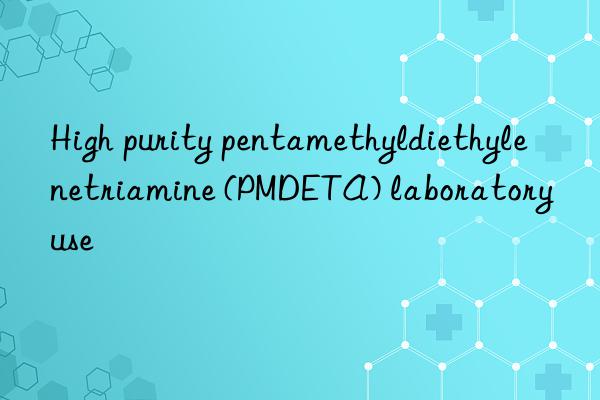
High purity pentamethyldiethylenetriamine (PMDETA), chemical name is N,N,N’,N’,N “-Pentamethyldiethylenetriamine is an organic compound with special properties. Because of its unique structure and high reactivity, PMDETA plays an important role in laboratory research and chemical synthesis. It will be introduced in detail below High purity PMDETA has many uses in the laboratory.
Laboratory synthesis and catalysis
1. Catalysts in organic synthesis
PMDETA, as a strongly basic tertiary amine, can be used as a catalyst in organic synthesis, especially in asymmetric synthesis, it can promote the construction of chiral centers. In the laboratory, it can be used to catalyze various types of reactions, such as Michael addition, Mannich reaction, aldol condensation, etc. Among them, PMDETA can help control the selectivity and yield of the reaction, especially in stereoselectivity. Play an important role in synthesis.
2. Ligands of metal complexes
High-purity PMDETA is often used as a ligand for metal complexes to prepare metal-organic frameworks (MOFs) with specific functions, complex catalysts, etc. It can form stable complexes with metal ions, and these complexes show potential applications in catalysis, adsorption, separation and storage of gases such as hydrogen and carbon dioxide.
Analytical Chemistry and Detection
3. Analytical reagents
In analytical chemistry, PMDETA can be used as a reagent to participate in quantitative analysis, such as an indicator or standard solution component in titration analysis, used to determine the concentration of acidic substances or specific metal ions. Its high purity ensures the accuracy and reliability of analytical results.
4. Mass Spectrometry Analysis
PMDETA can also be used as an ionization reagent in mass spectrometry analysis to help improve the ionization efficiency of certain compounds, thereby enhancing signal intensity and making the detection of low-concentration substances possible.
Material science and surface modification
5. Surface Modifier
In the field of materials science, PMDETA can be used to modify solid surfaces, such as amination treatment of metal, semiconductor and ceramic surfaces, to improve the wettability, adhesion and reactivity of materials. This modification is of great significance for nanotechnology, biomedical materials and microelectronic device manufacturing.
6. Polymer functionalization
PMDETA can also participate in polymerization reactions as a functional monomer, introducing amine groups to the polymer chain, thereby changing the physical and chemical properties of the polymer, such as improving the solubility, reactivity and compatibility with other materials of the polymer. Capacity.
Biochemistry and Medicinal Chemistry
7. Drug synthesis and carrier design
In the fields of biochemistry and medicinal chemistry, PMDETA can be used in the design and synthesis of drug molecules, especially as part of a carrier molecule for the preparation of drug delivery systems such as liposomes and nanoparticles to improve the target of drugs. tropism and bioavailability.
Environmental Science and Energy Technology
8. Carbon dioxide capture
PMDETA has been proven to be an effective carbon dioxide absorber and can be used in carbon dioxide capture technologies in environmental science to help reduce greenhouse gas emissions. Its efficient absorption performance and low regeneration energy consumption enable it to show application potential in carbon capture and storage (CCS) technology.
Conclusion
In summary, high-purity pentamethyldiethylenetriamine (PMDETA) has a wide range of applications in laboratories, from It plays an irreplaceable role in everything from organic synthesis to materials science to the environment and medicine. Its high purity ensures the accuracy of experimental results and the reliability of scientific research. It is one of the indispensable chemicals in modern laboratories.
Extended reading:
bismuth neodecanoate/CAS 251-964-6 – Amine Catalysts (newtopchem.com)
stannous neodecanoate catalysts – Amine Catalysts (newtopchem.com)
polyurethane tertiary amine catalyst/Dabco 2039 catalyst – Amine Catalysts (newtopchem.com)
N-Methylmorpholine – morpholine

 微信扫一扫打赏
微信扫一扫打赏

